RARZ: Ring-Zone Based Routing Protocol for Wireless Sensor Networks
Abstract
1. Introduction
2. Related Work
2.1. Centralized Approaches
2.2. Distributed Approaches
2.3. Quality of Service Approaches (QoS)
2.4. Neuro-Fuzzy Approaches
2.5. Cross-Layer Design Approaches
3. RARZ Protocol
3.1. Network Model
- All the nodes are static.
- The nodes are capable of varying their transmission power.
- The data sampling rate is fixed.
- The BS is located somewhere in the sensing region.
- All the nodes are homogenous with a limited battery power, except for the BS.
3.2. RARZ Protocol Phases
3.2.1. Network Configuration Phase
3.2.2. Data Communication Phase
3.3. Next Hop Node Selection
3.4. Message Formats Used in RARZ
3.5. Protocol Description
| Algorithm 1: Pseudo code for Network Configuration/setup phase |
|
| Algorithm 2: Pseudo code for Data Communication phase |
|
3.6. RARZ Algorithm (Example Scenario Taken from Simulation)
- In Figure 6, Node S (Red Node) in ring 4 broadcasts the packet. Nodes in the lower rings 3 and 2 will receive the packet and start their timers as per Equation (1).
- The timer of the node (blue) located in ring 2 expired first due to its energy level being the highest and its location (ringID 2) as compared to the nodes in ring 3.
- Upon receiving the packet, which is sent by a node (blue) in ring 2, nodes (green) in ring 3 will cancel their timers. The nodes (yellow) in ring 1 will start their timers because they are located in the lower ring. The time of the node having a higher energy level will expire first and then it relays the received packet to BS. Hence the packet reaches BS in three hops instead of four.
4. Simulation and Results
4.1. Energy Model
4.2. Results and Discussion
- Average energy consumption (to check the average energy consumption in the system as time increments using the First Order Radio Model (FORM) model);
- Average delay (latency) (average time required to transmit a packet from source to final destination (BS));
- Average hop count (this parameter actually counts the total number of hops while sending packets using the RARZ scheme over time in the network w.r.t other protocols);
- Delivery ratio (to define this parameter for evaluation requires that the total number of successfully transmitted and received packets in the network after any given time);
- Number of nodes still alive over time (through this parameter we can easily check the number of alive and dead nodes over time, and observe the overall network lifetime as time increments).
5. Conclusions
Author Contributions
Funding
Acknowledgments
Conflicts of Interest
References and Note
- Zahmati, A.S.; Abolhassani, B.; Shirazi, A.A.B.; Bakhtiari, A.S. An energy-efficient protocol with static clustering for wireless sensor networks. Int. J. Electron. Circuits Syst. 2007, 1, 135–138. [Google Scholar]
- Heinzelman, W.R.; Chandrakasan, A.; Balakrishnan, H. Energy-efficient communication protocol for wireless microsensor networks. In Proceedings of the 33rd Annual Hawaii International Conference on System Sciences, Maui, HI, USA, 4–7 January 2000. [Google Scholar]
- Heinzelman, W.R.; Sinha, A.; Wang, A.; Chandrakasan, A.P. Energy-scalable algorithms and protocols for wireless microsensor networks. In Proceedings of the 2000 IEEE International Conference on Acoustics, Speech, and Signal Processing (ICASSP’00), Istanbul, Turkey, 5–9 June 2000; pp. 3722–3725. [Google Scholar]
- Hall, D.L.; McMullen, S.A. Mathematical Techniques in Multisensor Data Fusion; Artech House: Norwood, MA, USA, 2004. [Google Scholar]
- Heinzelman, W.B.; Chandrakasan, A.P.; Balakrishnan, H. An application-specific protocol architecture for wireless microsensor networks. IEEE Trans. Wirel. Commun. 2002, 1, 660–670. [Google Scholar] [CrossRef]
- Stojmenovic, I. Position-based routing in ad hoc networks. IEEE Commun. Mag. 2002, 40, 128–134. [Google Scholar] [CrossRef]
- Kulkarni, S.; Iyer, A.; Rosenberg, C. An address-light, integrated MAC and routing protocol for wireless sensor networks. IEEE/ACM Trans. Netw. 2006, 14, 793–806. [Google Scholar] [CrossRef]
- Jiang, Q.; Manivannan, D. Routing protocols for sensor networks. In Proceedings of the First IEEE Consumer Communications and Networking Conference (CCNC 2004), Las Vegas, NV, USA, 5–8 January 2004; pp. 93–98. [Google Scholar]
- Baker, D.; Ephremides, A.; Flynn, J. The design and simulation of a mobile radio network with distributed control. IEEE J. Sel. Areas Commun. 1984, 2, 226–237. [Google Scholar] [CrossRef]
- Lindsey, S.; Raghavendra, C.S. PEGASIS: Power-efficient gathering in sensor information systems. In Proceedings of the Aerospace Conference Proceedings, Big Sky, MT, USA, 9–16 March 2002. [Google Scholar]
- Muruganathan, S.D.; Ma, D.C.; Bhasin, R.I.; Fapojuwo, A.O. A centralized energy-efficient routing protocol for wireless sensor networks. IEEE Commun. Mag. 2005, 43, S8–S13. [Google Scholar] [CrossRef]
- Shen, H. Finding the k most vital edges with respect to minimum spanning tree. Acta Inform. 1999, 36, 405–424. [Google Scholar] [CrossRef]
- Huang, B.; Hao, F.; Zhu, H.; Tanabe, Y.; Baba, T. Low-energy static clustering scheme for wireless sensor network. In Proceedings of the International Conference on Wireless Communications, Networking and Mobile Computing (WiCOM 2006), Wuhan, China, 22–24 September 2006; pp. 1–4. [Google Scholar]
- Madani, S.A.; Weber, D.; Mahlknecht, S. Position-based Routing Protocol for Low Power Wireless Sensor Networks. J. UCS 2010, 16, 1215–1233. [Google Scholar]
- Hussain, S.; Matin, A.W.; Islam, O. Genetic algorithm for energy efficient clusters in wireless sensor networks. In Proceedings of the Fourth International Conference on Information Technology (ITNG’07), Las Vegas, NV, USA, 2–4 April 2007; pp. 147–154. [Google Scholar]
- Yin, L.; Wang, C.; Øien, G.E. An energy-efficient routing protocol for event-driven dense wireless sensor networks. Int. J. Wirel. Inf. Netw. 2009, 16, 154. [Google Scholar] [CrossRef]
- Kim, S. Online energy efficient routing approach for QoS-sensitive wireless sensor networks. In Proceedings of the International Conference on Information Networking (ICOIN 2009), Chiang Mai, India, 21–24 January 2009. [Google Scholar]
- Le, H.-P.; John, M.; Pister, K. Energy-Aware Routing in Wireless Sensor Networks with Adaptive Energy-Slope Control (Lecture notes), Retrieved from University of California Berkley, EE290Q-2 Spring 2009.
- Nehra, N.K.; Kumar, M.; Patel, R. Neural Network based energy efficient clustering and routing in wireless sensor networks. In Proceedings of the First International Conference on Networks and Communications (NETCOM’09), Chennai, India, 27–29 December 2009; pp. 34–39. [Google Scholar]
- Cho, S.; Shrestha, B.; La, K.-H.; Hong, B.; Lee, J. An energy-efficient cluster-based routing in wireless sensor networks. In Communication and Networking; Springer: New York, NY, USA, 2011; pp. 15–22. [Google Scholar]
- Xu, W.J.; Sun, L.J.; Guo, J.; Wang, R.C. A Small World Routing Protocol in Wireless Sensor Networks. In Key Engineering Materials; Trans Tech Publications Ltd.: Stafa-Zurich, Switzerland, 2011; pp. 828–833. [Google Scholar]
- Pavithra, G.; Devaki, P. Link and location based routing mechanism for energy efficiency in wireless sensor networks. arXiv, 2014; arXiv:1403.1655. [Google Scholar]
- Chen, H.; Lv, Z.; Tang, R.; Tao, Y. Clustering energy-efficient transmission protocol for Wireless Sensor Networks based on ant colony path optimization. In Proceedings of the 2017 International Conference on Computer, Information and Telecommunication Systems (CITS), Dalian, China, 21–23 July 2017; pp. 15–19. [Google Scholar]
- Kannan, K.N.; Paramasivan, B. Development of energy-efficient routing protocol in wireless sensor networks using optimal gradient routing with on demand neighborhood information. Int. J. Distrib. Sens. Netw. 2014, 10. [Google Scholar] [CrossRef]
- Mahlknecht, S.; Madani, S.A.; Rötzer, M. Energy aware distance vector routing scheme for data centric low power wireless sensor networks. In Proceedings of the 2006 IEEE International Conference on Industrial Informatics, Singapore, 6–18 August 2006; pp. 1030–1035. [Google Scholar]
- Ben-Othman, J.; Yahya, B. Energy efficient and QoS based routing protocol for wireless sensor networks. J. Parallel Distrib. Comput. 2010, 70, 849–857. [Google Scholar] [CrossRef]
- Sabor, N.; Sasaki, S.; Abo-Zahhad, M.; Ahmed, S.M. A comprehensive survey on hierarchical-based routing protocols for mobile wireless sensor networks: Review, taxonomy, and future directions. Wirel. Commun. Mob. Comput. 2017, 2017, 2818542. [Google Scholar] [CrossRef]
- Sharma, S.; Puthal, D.; Jena, S.K.; Zomaya, A.Y.; Ranjan, R. Rendezvous based routing protocol for wireless sensor networks with mobile sink. J. Supercomput. 2017, 73, 1168–1188. [Google Scholar] [CrossRef]
- Madani, S.A.; Mahlknecht, S.; Glaser, J. CLAMP: Cross layer management plane for low power wireless sensor networks. In Proceedings of the 5th International Workshop on Frontiers of Information Technology, Islamabad, Pakistan, 17–18 December 2007; Citeseer: Forest Grove, OR, USA, 2007. [Google Scholar]
- Hajian, E.; Jamshidi, K.; Bohlooli, A. Improve energy efficiency routing in WSN by using automata. Int. J. Ad Hoc Sens. Ubiq. Comput. 2010, 1, 1–7. [Google Scholar] [CrossRef]
- Jadoon, R.N.; Shafi, J.; Hussain, S.A. Beacon based controlled routing in wireless sensor networks. In Proceedings of the 2012 International Conference on Computer Systems and Industrial Informatics (ICCSII), Sharjah, UAE, 18–20 December 2012; pp. 1–5. [Google Scholar]
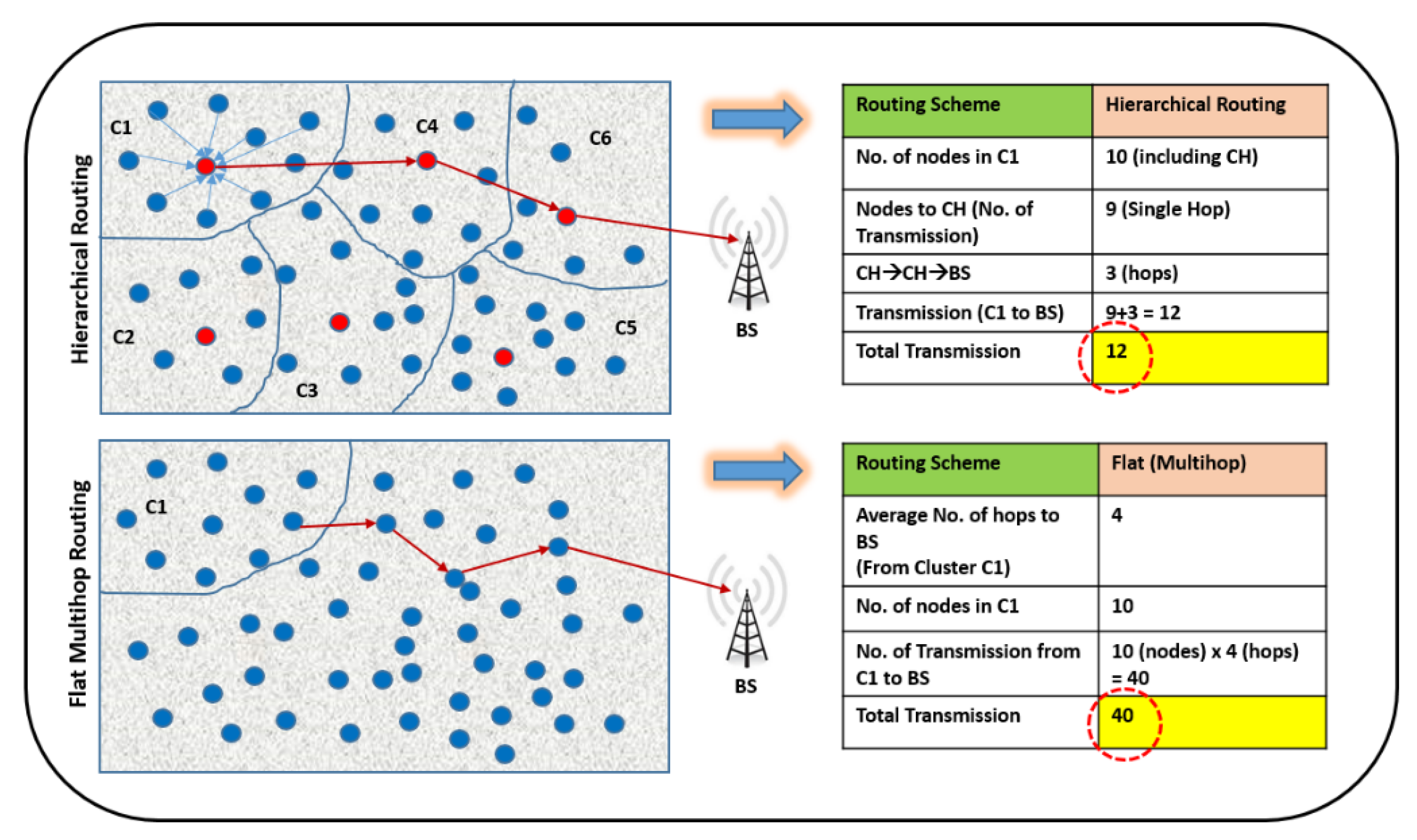
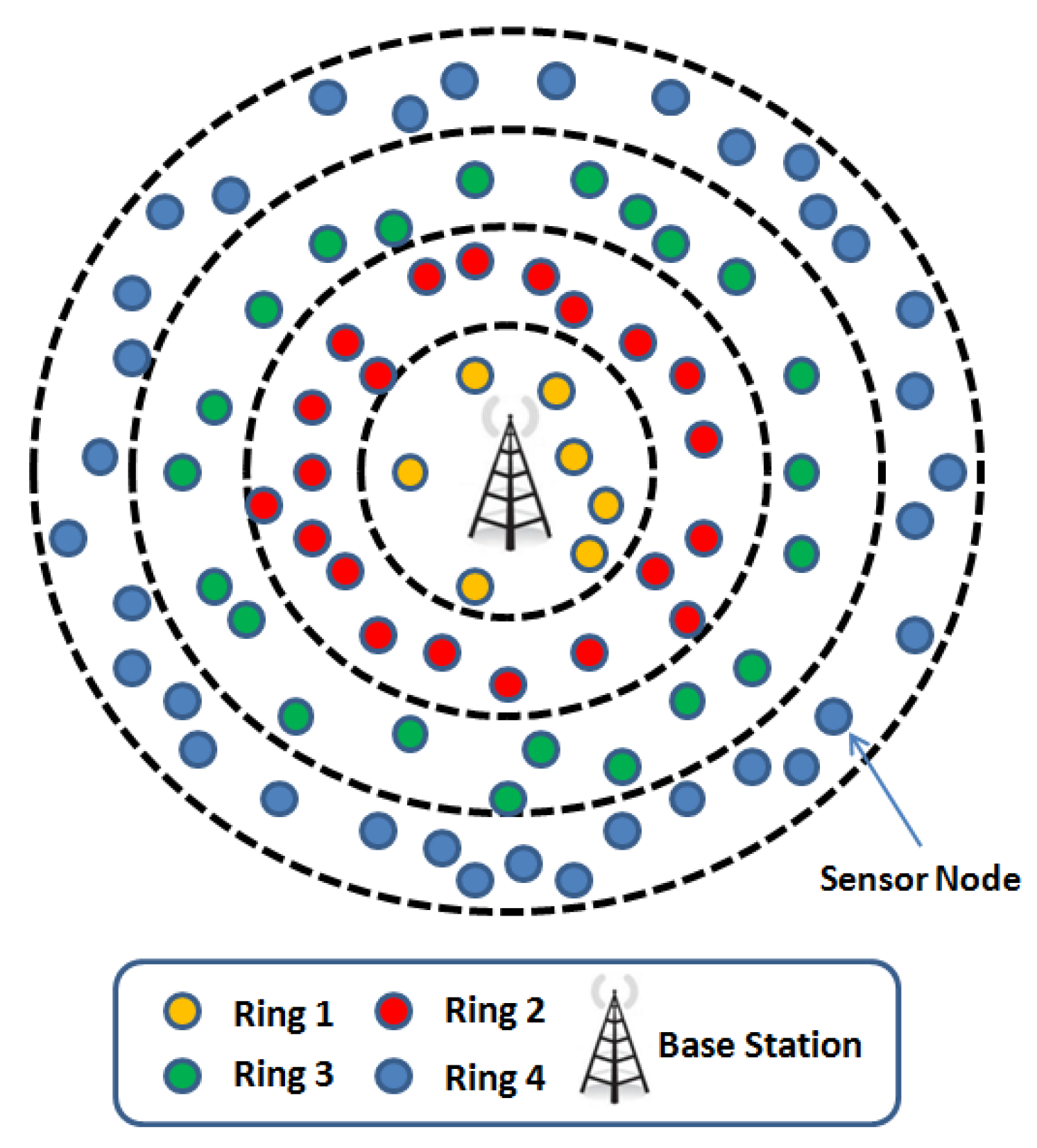

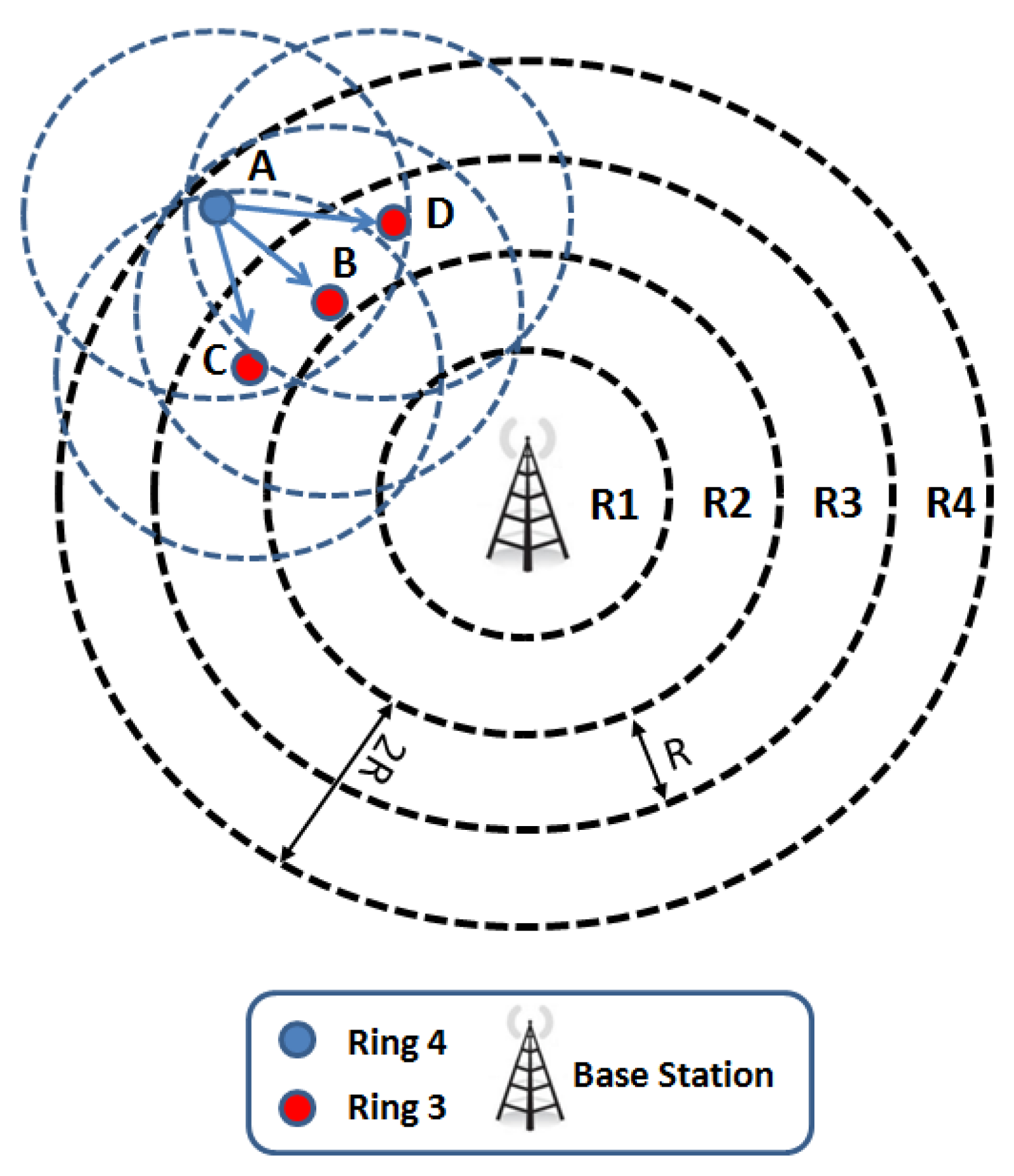

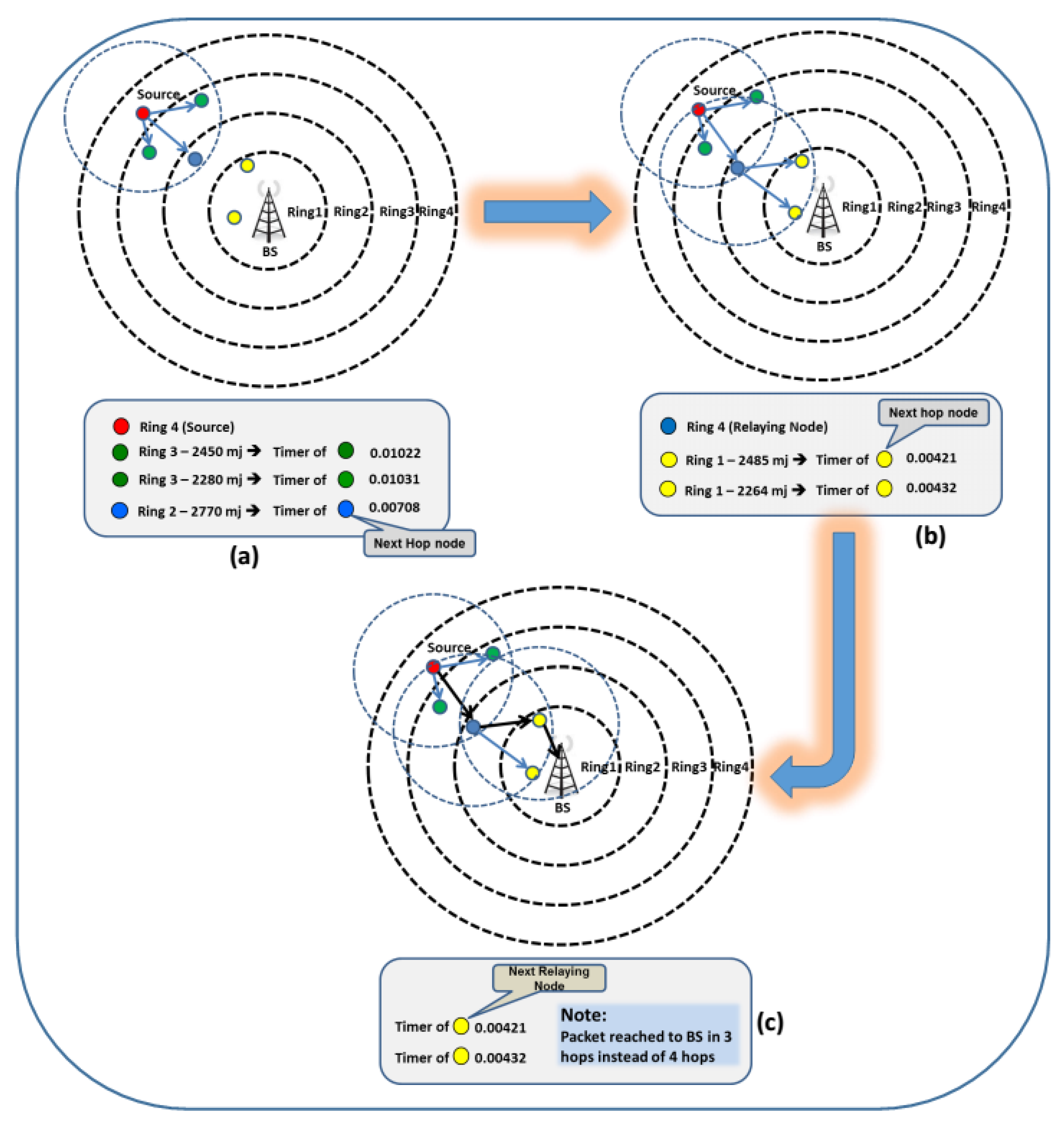
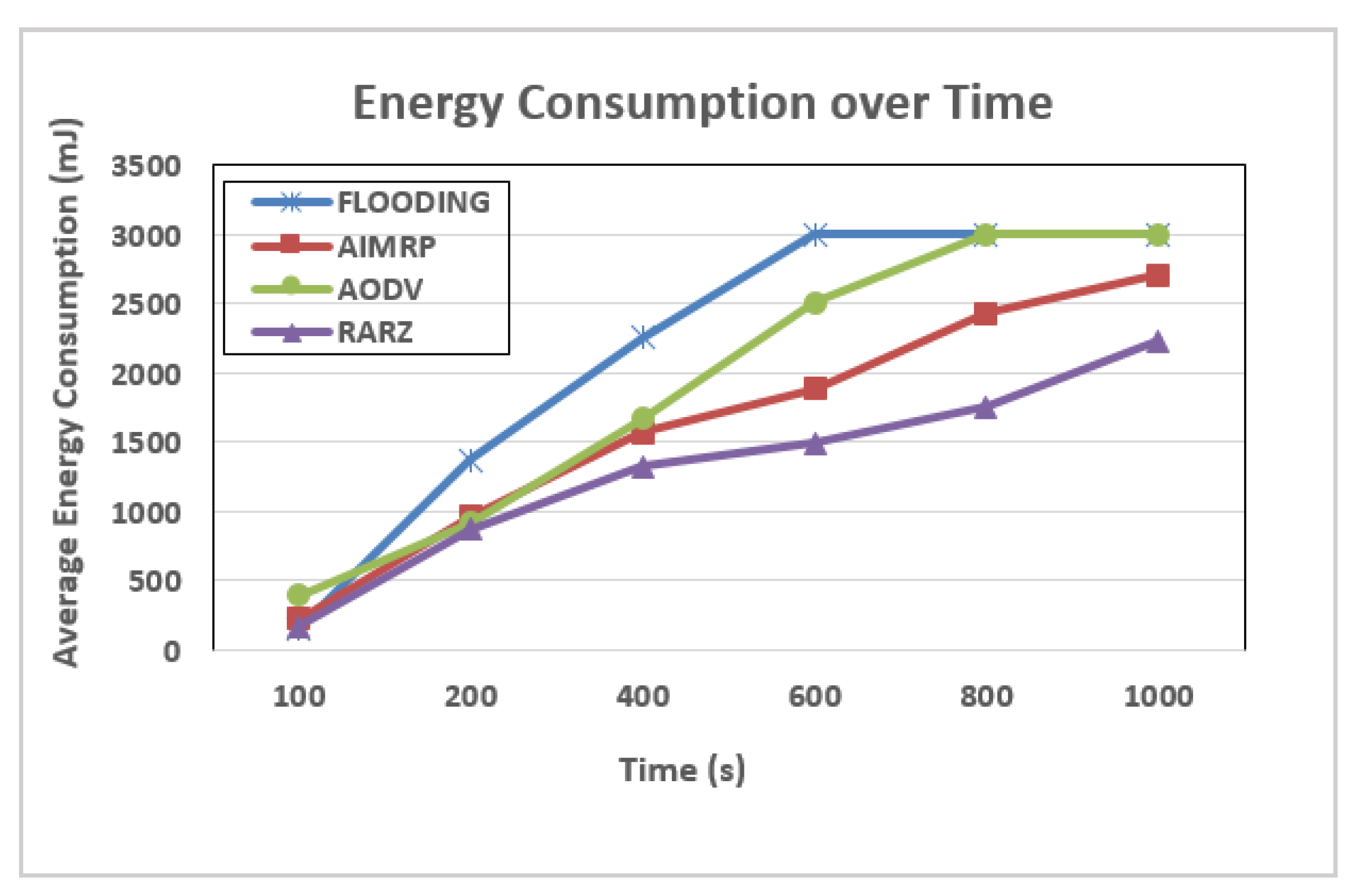
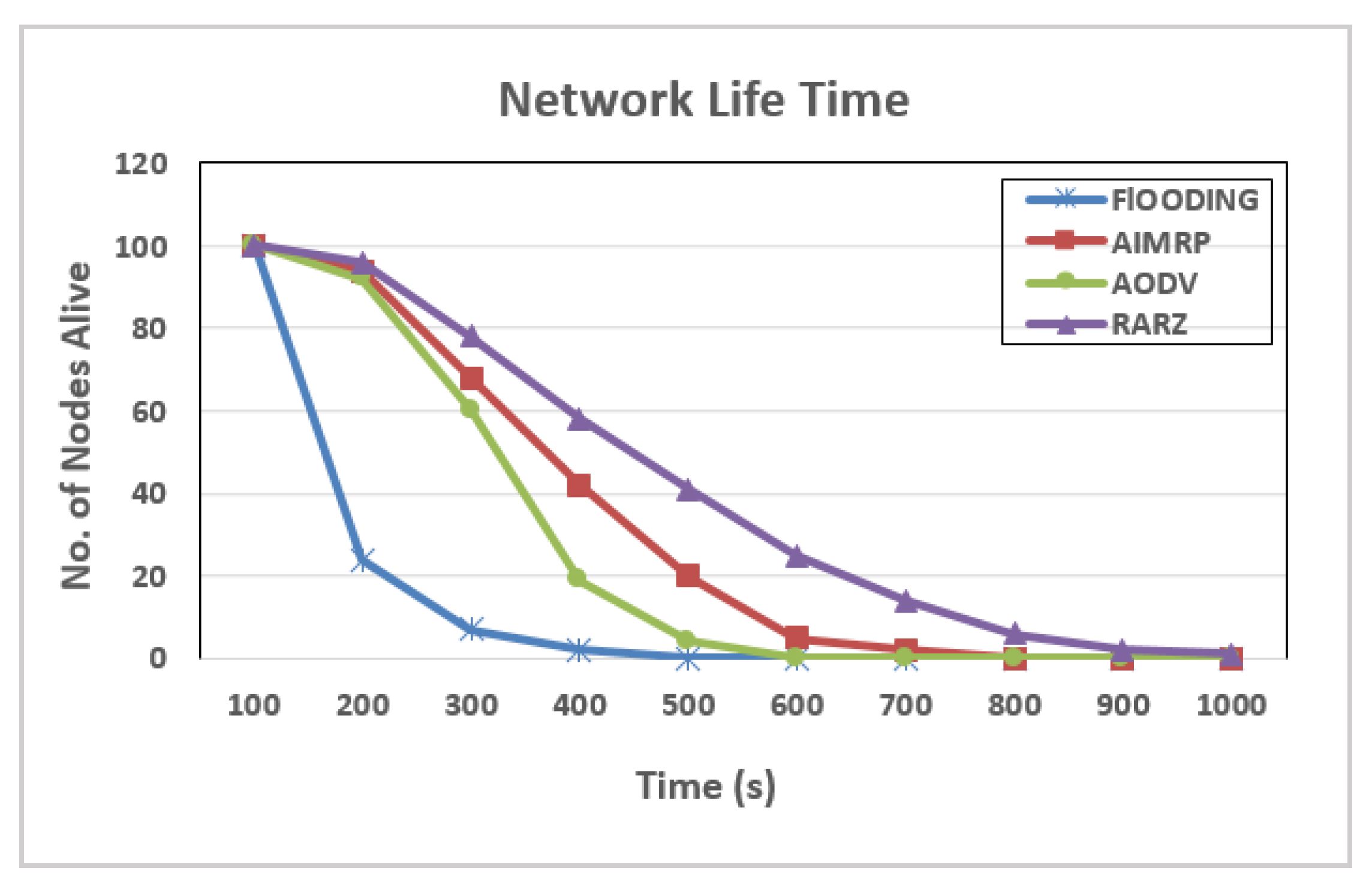

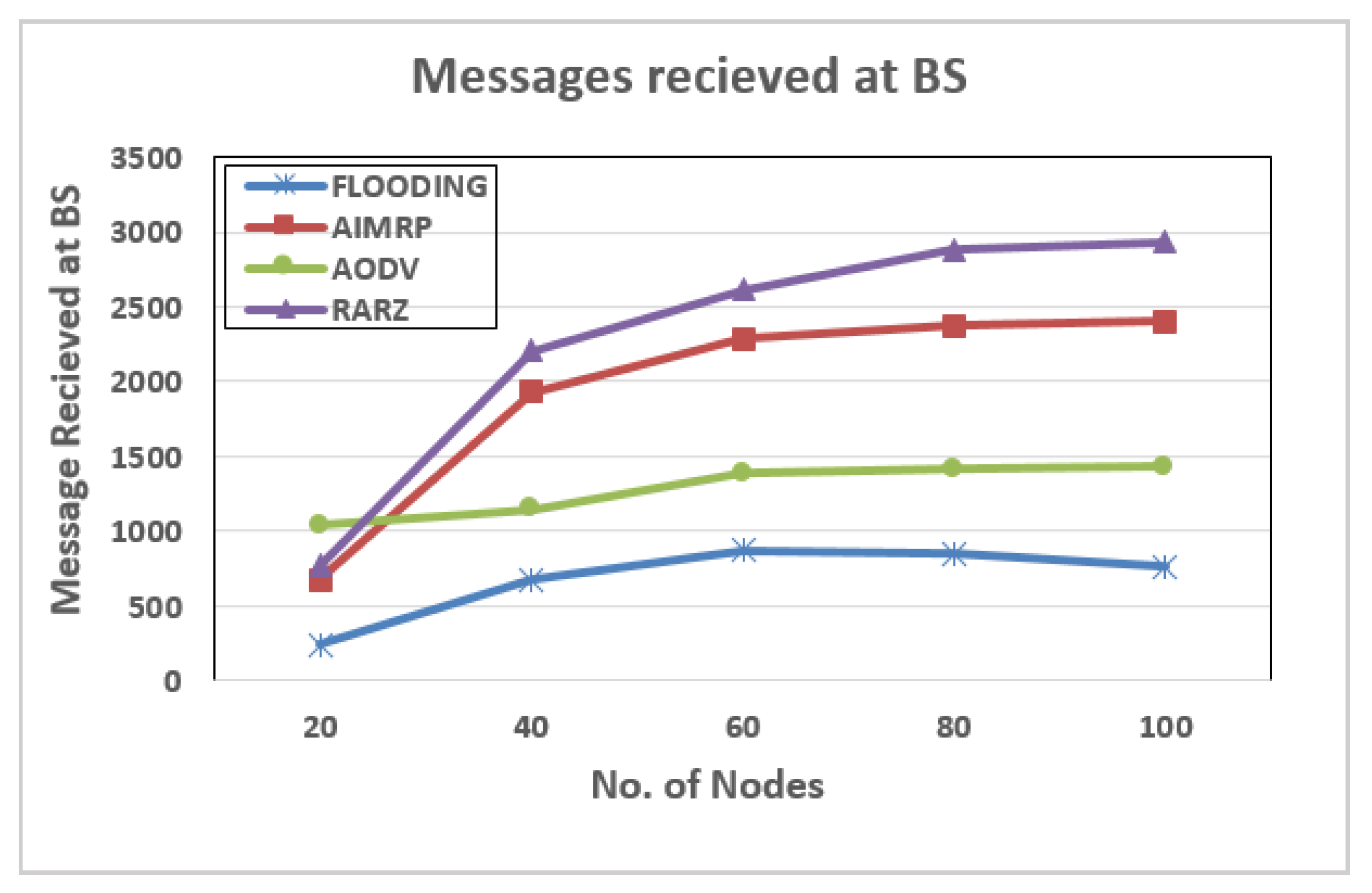

| Routing protocols | Primary Objective | Centralize/Distributed | Sensor Nodes (Mobile/Static) | Protocol Category | Sink (Mobile/Static) | Position Aware (Y/N) | (Single/Multi-hops) | Energy Efficient | Cross-Layer (Y/N) |
|---|---|---|---|---|---|---|---|---|---|
| LEACH-C [5] | Extending network lifetime | Centralized | Static | Hierarchical | Static | Yes | Multihop | Yes | No |
| LEACH [1,5,8] | Extending network lifetime | Distributed | Static | Hierarchical | Static | Yes | Multihop | Yes | No |
| PEGASIS [10] | Extending network lifetime | Chain-based | Static | Hierarchical | Static | No | Multihop | Yes | No |
| LESCS [13] | Solving hotspot problem | Centralized | Static | Hierarchical | Static | Yes | Multihop | Yes | No |
| HCR [15] | Efficient cluster formation | Centralized | Static | Hierarchical | Static | Yes | Multihop | Yes | No |
| AESC [18] | Keep nodes alive for a given time period | Distributed | Static | Flat | Static | No | Multihop | Yes | No |
| TPR [14] | Extending network lifetime, Greedy forwarding | Distributed | Mobile | Flat | Static | Yes | Multihop | Yes | Yes |
| EADV [25] | Extending network life time | Distributed | Static | Flat | Static | No | Multihop | Yes | No |
| CLAMP [29] | Extending network lifetime | Distributed | Mobile | Flat | Mobile | Yes | Multihop | Yes | Yes |
| ELECP [20] | Extending network lifetime | Distributed | Static | Flat | Static | No | Multihop | Yes | No |
| EEPSC [1] | Extending network lifetime | Centralized | Static | Hierarchical | Static | No | Direct | Yes | No |
| AIMRP [7] | Extending network lifetime | Centralized | Static | Flat | Static | No | Multihop | Yes | Yes |
| Type | Parameters | Values |
|---|---|---|
| Network | Field dimension | 600 × 600 m |
| Initial energy of each node | 3 J/battery | |
| Location of each node | Random | |
| Number of rings/zones | 10 | |
| Application | Data packet size | 100 bytes |
| Broadcast packet size | 25 bytes | |
| Packet header size | 25 bytes | |
| Radio Model | 50 nJ/bit | |
| 0.13 nJ/bit |
© 2018 by the authors. Licensee MDPI, Basel, Switzerland. This article is an open access article distributed under the terms and conditions of the Creative Commons Attribution (CC BY) license (http://creativecommons.org/licenses/by/4.0/).
Share and Cite
Jadoon, R.N.; Zhou, W.; Jadoon, W.; Ahmed Khan, I. RARZ: Ring-Zone Based Routing Protocol for Wireless Sensor Networks. Appl. Sci. 2018, 8, 1023. https://doi.org/10.3390/app8071023
Jadoon RN, Zhou W, Jadoon W, Ahmed Khan I. RARZ: Ring-Zone Based Routing Protocol for Wireless Sensor Networks. Applied Sciences. 2018; 8(7):1023. https://doi.org/10.3390/app8071023
Chicago/Turabian StyleJadoon, Rab Nawaz, WuYang Zhou, Waqas Jadoon, and Iftikhar Ahmed Khan. 2018. "RARZ: Ring-Zone Based Routing Protocol for Wireless Sensor Networks" Applied Sciences 8, no. 7: 1023. https://doi.org/10.3390/app8071023
APA StyleJadoon, R. N., Zhou, W., Jadoon, W., & Ahmed Khan, I. (2018). RARZ: Ring-Zone Based Routing Protocol for Wireless Sensor Networks. Applied Sciences, 8(7), 1023. https://doi.org/10.3390/app8071023








